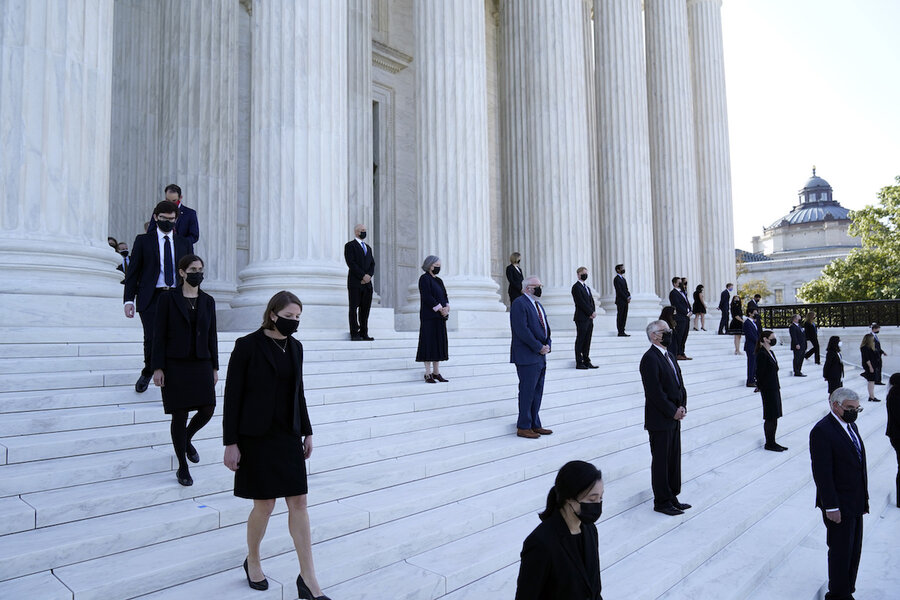Thousands to pay respects to Justice Ginsburg at Supreme Court
Loading...
Thousands of people are expected to pay their respects at the Supreme Court to the late Justice Ruth Bader Ginsburg, the women’s rights champion, leader of the court’s liberal bloc, and feminist icon who died last week.
Even with the court closed to the public because of the coronavirus pandemic and Washington already consumed with talk of Justice Ginsburg’s replacement, the justice’s former colleagues, family, close friends, and the public will have the chance on Wednesday and Thursday to pay their respects to the second woman to serve on the Supreme Court.
Justice Ginsburg’s flag-draped casket arrived at the court at 9:30 a.m. and was carried into the court’s Great Hall, past her former law clerks who lined the steps. Inside, the court’s remaining eight justices were together for the first time since the building was closed in March and they resorted to meetings by telephone.
Justice Ginsburg will lie in repose for two days at the court where she served for 27 years and, before that, argued six cases for gender equality in the 1970s.
Nearly 200 members of the public had gathered to pay their respects by early morning, intermingling with dog walkers and joggers who cut through the crowd. At the front of the crowd were attorneys Cara Stewart and Jenny Beene-Skuban, who drove overnight from the Cincinnati area to be there.
“I felt like I couldn’t not be here,” said Ms. Stewart, a public-interest lawyer from Martin, Kentucky.
Ms. Stewart said she particularly identified with Justice Ginsburg’s early career as a civil rights advocate.
“What moves me more is her career before the court,” she said. “Using the courts for justice and being successful – that’s not easy to do.”
Ms. Beene-Skuban, of Cincinnati, said Justice Ginsburg’s career blazed trails for women who came after her.
“We’re here to recognize the shoulders we’re standing on,” she said.
Outside the building, chairs and monitors were set up.
Following a private ceremony Wednesday in the court’s Great Hall, her casket will be moved outside the building to the top of the court’s front steps so that public mourners can pay their respects in line with public health guidance for the pandemic.
Since her death Friday evening, people have been leaving flowers, notes, placards, and all manner of Ginsburg paraphernalia outside the court in tribute to the woman who became known in her final years as the “Notorious RBG.” Court workers cleared away the items and cleaned the court plaza and sidewalk in advance of Wednesday’s ceremony.
Justice Ginsburg will lie in repose on the Lincoln Catafalque, the platform on which President Abraham Lincoln’s coffin rested in the Capitol rotunda in 1865. A 2016 portrait of Ginsburg by artist Constance P. Beaty will be displayed nearby.
President Donald Trump is expected to visit the court before he leaves town Wednesday afternoon. He paid respects when Justice John Paul Stevens died last year and President Barack Obama visited the court after Justice Antonin Scalia’s death in 2016.
The entrance to the courtroom, along with Justice Ginsburg’s chair and place on the bench next to Chief Justice Roberts, have been draped in black, a longstanding court custom. These visual signs of mourning, which in years past have reinforced the sense of loss, will largely go unseen this year. The court begins its new term Oct. 5, but the justices will not be in the courtroom and instead will hear arguments by phone.
Heather Setzler, a physician’s assistant from Raleigh, North Carolina, started her drive at 1 a.m. to be at the court.
Ms. Setzler said on annual trips to Washington she always set aside an hour or so to tour the Supreme Court and hang out in the cafeteria, hoping for an impromptu chance to meet.
She appreciated not only the serious legacy she left behind but was also a fan of the pop culture phenomenon that surrounded the Notorious RBG, naming her two cats Hillary Ruth and Kiki, in honor of Justice Ginsburg’s childhood nickname.
“There was just something about her. She was so diminutive yet turned out to be such a giant,” Ms. Setzler said, wearing a face mask adorned with small portraits of Ginsburg.
Ms. Setzler said she’s frightened by the prospect that Justice Ginsburg’s replacement could lock the court into a solid conservative majority.
“It pains me to think that everything she worked so hard for could be turned around in a couple of years,” she said.
On Friday, Justice Ginsburg will lie in state at the Capitol, the first woman to do so and only the second Supreme Court justice after William Howard Taft. Taft had also been president. Rosa Parks, a private citizen as opposed to a government official, is the only woman who has lain in honor at the Capitol.
Justice Ginsburg will be buried beside her husband, Martin, in a private ceremony at Arlington National Cemetery next week. Martin Ginsburg died in 2010. She is survived by a son and a daughter, four grandchildren, two step-grandchildren, and a great-grandchild.
This story was reported by The Associated Press. Associated Press Writer Matthew Barakat contributed to this report.







